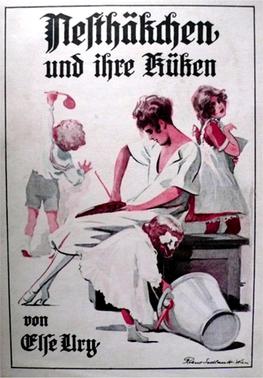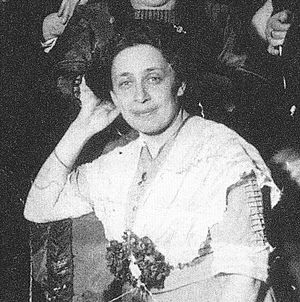Nesthäkchen and Her Chicks facts for kids
 |
|
| Author | Else Ury |
|---|---|
| Original title | Nesthäkchen und ihre Küken |
| Illustrator | Robert Sedlacek |
| Country | Germany |
| Language | German |
| Series | Nesthäkchen, volume 7 |
| Genre | Fiction/Adventure |
| Publisher | Meidingers Jugendschriften Verlag |
|
Publication date
|
1923 |
| Media type | Print (Hardcover) |
| Pages | 191 pp (Hardcover edition) |
| Preceded by | Nesthäkchen Flies From the Nest |
| Followed by | Nesthäkchen's Youngest |
Nesthäkchen und ihre Küken (which means Nesthäkchen and Her Chicks in English) is the seventh book in the popular ten-book Nesthäkchen series by Else Ury. This exciting volume was first published in 1923. The main character, Nesthäkchen, is a girl named Annemarie Braun. She is a doctor's daughter from Berlin, known for her slim figure and golden-blond hair. The series follows Annemarie through her whole life, from when she was a baby (Nesthäkchen and Her Dolls) all the way to her old age with grandchildren (Nesthäkchen with White Hair). In Nesthäkchen und ihre Küken, you'll read about Annemarie's early years as a mom.
Contents
The Story's Adventure
This book jumps forward in time from when Else Ury was writing it. It describes Annemarie's life in the future. Annemarie Braun was born in 1903 and got married when she was 20. In this story, she is celebrating her seventh wedding anniversary.
Meet the Family
"Nesthäkchen and Her Chicks" starts with Annemarie and Rudolf's seventh wedding anniversary. They now have three children: Vronli, who is six; Hans, who is three; and Ursel, who is two. They live in Berlin-Lichterfelde. Annemarie's parents, "Omama" and "Opapa," are now loving grandparents. Her grandmother is called "Urmütterchen," and her Aunt Albertina is "Urtantchen" by Annemarie’s children.
Annemarie's brother, Hans, is a judge. He is married to Rudolf's sister, Ola, and they have two sons, Herbert and Waldemar. Klaus, another brother, is a farmer and is still single. He really likes Annemarie’s friend, Ilse Hermann. Ilse and Marlene Ulrich are cousins and best friends. They both work as teachers at a girls' school. Margot and Vera are also unmarried and have jobs. Margot runs a dressmaking business, and Vera is a photographer.
A Big Fire and New Homes
One day, Annemarie's daughter Vronli starts school. While she is away, Hans and Ursel are home alone. They find their father’s matches, and Hans accidentally starts a fire. Their house burns down, leaving the family without a home.
They find a place to stay with their kind neighbor, Mr. Pfefferkorn. He is an old bachelor who loves children, even though his housekeeper, Mrs. Luebke, is a bit grumpy. Later, Annemarie and the children move in with her parents. Annemarie and Rudolf worry about money. Annemarie wants to earn money to help her husband. However, she cannot carry out this plan. This part of the story shows the tough economic times in Germany during the early 1920s.
Illness and Celebrations
Later that winter, the children get very sick with the flu. Luckily, they all get better. The family celebrates "Urmütterchen’s" seventieth birthday. Soon after, "Urtantchen" passes away.
Summer in the Countryside
In the summer, Annemarie travels with her children, Ilse, and Marlene. They visit her brother Klaus in the countryside of Pomerania. They stay at his farm, Lüttgenheide, which is near the Baltic Sea. Their cousin Peter lives nearby on his farm, Grotgenheide. The story ends happily with Klaus and Ilse getting engaged, and Peter and Marlene also getting engaged.
Author's Note
In the first versions of the book, Else Ury added a special note at the end. She wrote that she wasn't sure if she wanted to continue the Nesthäkchen series. But she decided to write more books because so many young readers sent her letters asking for them.
What Kind of Book Is It?
The Nesthäkchen books belong to a German type of literature called the Backfischroman. This means "girls' novel." These books tell stories about girls growing up and were written for readers aged 12 to 16. A "Backfisch" was a term for a teenage girl, usually between 14 and 17 years old.
Backfischroman novels were popular from about 1850 to 1950. They often showed girls learning about society's rules and expectations. The stories usually ended with the heroine getting married and becoming a homemaker.
Besides Else Ury, other famous Backfischroman authors included Magda Trott and Emmy von Rhoden, who wrote Der Trotzkopf. Henny Koch was also a well-known author in this style.
Else Ury had planned to finish the Nesthäkchen series with volume 6, Nesthäkchen Flies From the Nest. That book described Nesthäkchen's marriage. However, her publisher in Berlin received many letters from young fans. They begged Ury to write more Nesthäkchen stories. After thinking about it, Ury wrote four more books. She even mentioned her first doubts in the special note at the end of volume 7, "Nesthäkchen and Her Chicks."
About the Author: Else Ury
Else Ury (born November 1, 1877, in Berlin; died January 13, 1943, in the Auschwitz concentration camp) was a German writer. She was famous for her children's books. Her most well-known character is Annemarie Braun, the blonde doctor's daughter. Annemarie's life, from childhood to old age, is told in the ten very successful Nesthäkchen books.
These books, along with a six-part TV show called Nesthäkchen (made in 1983 and based on the first three books), have been enjoyed by millions of readers and viewers. A new DVD version was released in 2005.


